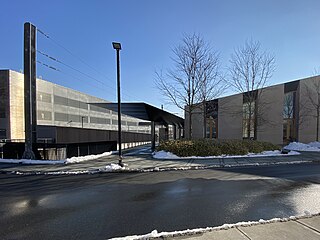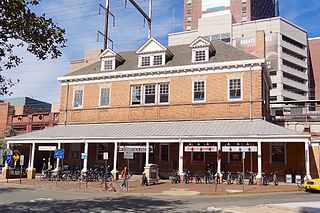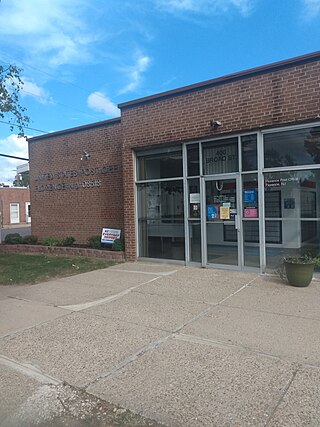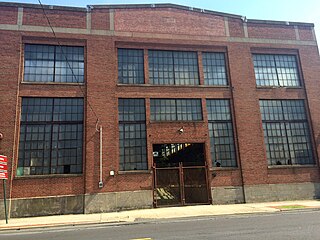
MARC is a commuter rail system in the Washington–Baltimore area. MARC is administered by the Maryland Transit Administration (MTA) and operated under contract by Alstom and Amtrak on track owned by CSX Transportation (CSXT) and Amtrak. In 2023, the system had a ridership of 3,860,600, or about 12,400 per weekday as of the fourth quarter of 2023, less than pre-COVID-19 pandemic weekday ridership of 40,000.

The River Line is a hybrid rail line in southern New Jersey that connects the cities of Camden and Trenton, New Jersey's capital. It is so named because its route between the two cities is parallel to the Delaware River.

The Northeast Corridor Line is a commuter rail service operated by NJ Transit between the Trenton Transit Center and New York Penn Station on Amtrak's Northeast Corridor in the United States. The service is the successor to Pennsylvania Railroad commuter trains between Trenton and New York, and is NJ Transit's busiest commuter rail service. After arrival at New York Penn Station, some trains load passengers and return to New Jersey, while others continue east to Sunnyside Yard for storage. Most servicing is done at the Morrisville Yard, at the west end of the line.
The United New Jersey Railroad and Canal Company (UNJ&CC) was a United States-based railroad company established in 1872. It was formed by the consolidation of three existing companies: the Camden and Amboy Railroad, Delaware and Raritan Canal Company, and New Jersey Rail Road and Transportation Company. The Camden and Amboy and New Jersey Rail Road were among the earliest North American railroads. The Pennsylvania Railroad leased the United New Jersey Railroad and Canal Company in 1872.

The SEPTA Regional Rail system is a commuter rail network owned by SEPTA and serving the Philadelphia metropolitan area. The system has 13 branches and more than 150 active stations in Philadelphia, Pennsylvania, its suburbs and satellite towns and cities. It is the sixth-busiest commuter railroad in the United States, and the busiest outside of the New York, Chicago, and Boston metropolitan areas. In 2016, the Regional Rail system had an average of 132,000 daily riders and 118,800 daily riders as of 2019.

Princeton is the northern terminus of the Princeton Branch commuter rail service operated by NJ Transit (NJT), and is located on the Princeton University campus in Princeton, New Jersey. At the branch's southern end at Princeton Junction, connections are available to NJT's Northeast Corridor Line and peak-hour Amtrak trains. The shuttle train between the two stations is known as the "Dinky", and has also been known as the "PJ&B", for "Princeton Junction and Back". Now running 2.7 mi (4.3 km) along a single track, it is the shortest scheduled commuter rail line in the United States. Initial studies have been conducted to add a bus transitway along the Dinky right-of-way as part of a proposed bus rapid transit system.

Trenton Transit Center is the main passenger train station in Trenton, New Jersey. It is the southernmost stop in New Jersey on the Northeast Corridor. It is the terminus for NJ Transit trains to and from New York City and SEPTA Trenton Line Regional Rail trains to and from Philadelphia, Pennsylvania, and an intermediate station for Amtrak trains traveling between the two cities along the Northeast Corridor.
The National Railway or National Air Line Railroad was a planned air-line railroad between New York City and Washington, D.C. in the United States around 1870. Part of it was eventually built from New York City to Philadelphia by the Delaware and Bound Brook Railroad and the Delaware River Branch of the North Pennsylvania Railroad, leased by the Philadelphia and Reading Railway, in 1879, and becoming its New York Branch. The line was intended to provide an alternate to the various monopolies that existed along the route, specifically the United New Jersey Railroad and Canal Companies and their Camden and Amboy Railroad, and as such had a long struggle to be built.

Ivy Ridge station is a SEPTA Regional Rail station in Philadelphia, Pennsylvania. Located at Umbria Street and Parker Avenue in Northwest Philadelphia, it serves the Manayunk/Norristown Line. The initial station was built in a minimalist design similar to that of Elm Street, Norristown. The current station has a 204-space parking lot. In FY 2013, Ivy Ridge station had a weekday average of 602 boardings and 582 alightings.

Rahway station is an NJ Transit train station in Rahway, New Jersey that is located 20.7 miles southwest of New York Penn Station, with service on the Northeast Corridor and North Jersey Coast lines.

New Brunswick is an active commuter railroad train station in the city of New Brunswick, Middlesex County, New Jersey, United States. The station services trains of New Jersey Transit's Northeast Corridor Line and Amtrak's Keystone Service and Northeast Regional. For New Jersey Transit trains, the next station to the southwest is Jersey Avenue, while the next station to the northeast is Edison. For Amtrak services, the next station southwest is Princeton Junction, the next station to the northeast is Metropark. The station consists of two handicap-accessible side platforms surrounding the four tracks.
The Bordentown Secondary was originally a freight railroad line in New Jersey, running from Pavonia Yard in Camden to Trenton. Today, a large portion of the line from Bordentown to Camden is used for New Jersey Transit's River Line light rail service. Conrail Shared Assets Operations continues to operate freight trains on the line, but these operations are restricted to overnight hours.

Roebling is an unincorporated community and census-designated place (CDP) located within Florence Township, in Burlington County, in the U.S. state of New Jersey, that was established as part of the 2010 United States census. As of the 2000 United States census, the CDP was combined as Florence-Roebling, which had a total population of 8,200. As of the 2010 Census, the Florence-Roebling CDP was split into its components, Florence and Roebling. As of the 2010 Census, the population of the Florence CDP was 4,426.

North Philadelphia station is an intercity rail and regional rail station on the Northeast Corridor, located on North Broad Street in the North Philadelphia neighborhood of Philadelphia, Pennsylvania, United States. SEPTA Regional Rail's Trenton Line and Chestnut Hill West Line account for most of the station's service. Three Amtrak trains, two southbound and one northbound, stop on weekdays only.

Middletown is a passenger railway station for New Jersey Transit's North Jersey Coast Line in Middletown Township, Monmouth County, New Jersey. Located along both sides of Church Street in Middletown, the station is the only active station within the township.
The Philadelphia, Newtown and New York Railroad was a railroad in southeastern Pennsylvania that is now a part of the SEPTA commuter rail system as the Fox Chase Branch. Despite the name, it only ever extended between Philadelphia and Newtown, Pennsylvania.
The Pemberton and Hightstown Railroad was a railroad in the U.S. state of New Jersey.

Belle Mead station is a train station along the CSX Trenton Subdivision and former New Jersey Transit West Trenton Line in the Belle Mead section of Montgomery Township, in Somerset County, New Jersey, United States.

Florence is an unincorporated community and census-designated place (CDP) located within Florence Township, in Burlington County, in the U.S. state of New Jersey, that was established as part of the 2010 United States Census. As of the 2000 United States Census, the CDP was combined as Florence-Roebling, which had a total population of 8,200. As of the 2010 Census, the Florence-Roebling CDP was split into its components, Roebling and Florence. As of the 2010 Census, the population of the Florence CDP was 4,426.

John A. Roebling's Sons Company, Trenton N.J., Block 3 is the northern portion of the former Roebling manufacturing complex in Trenton, New Jersey. The buildings date from 1908–1929 and the site was added to the National Register of Historic Places on August 22, 2012.
















